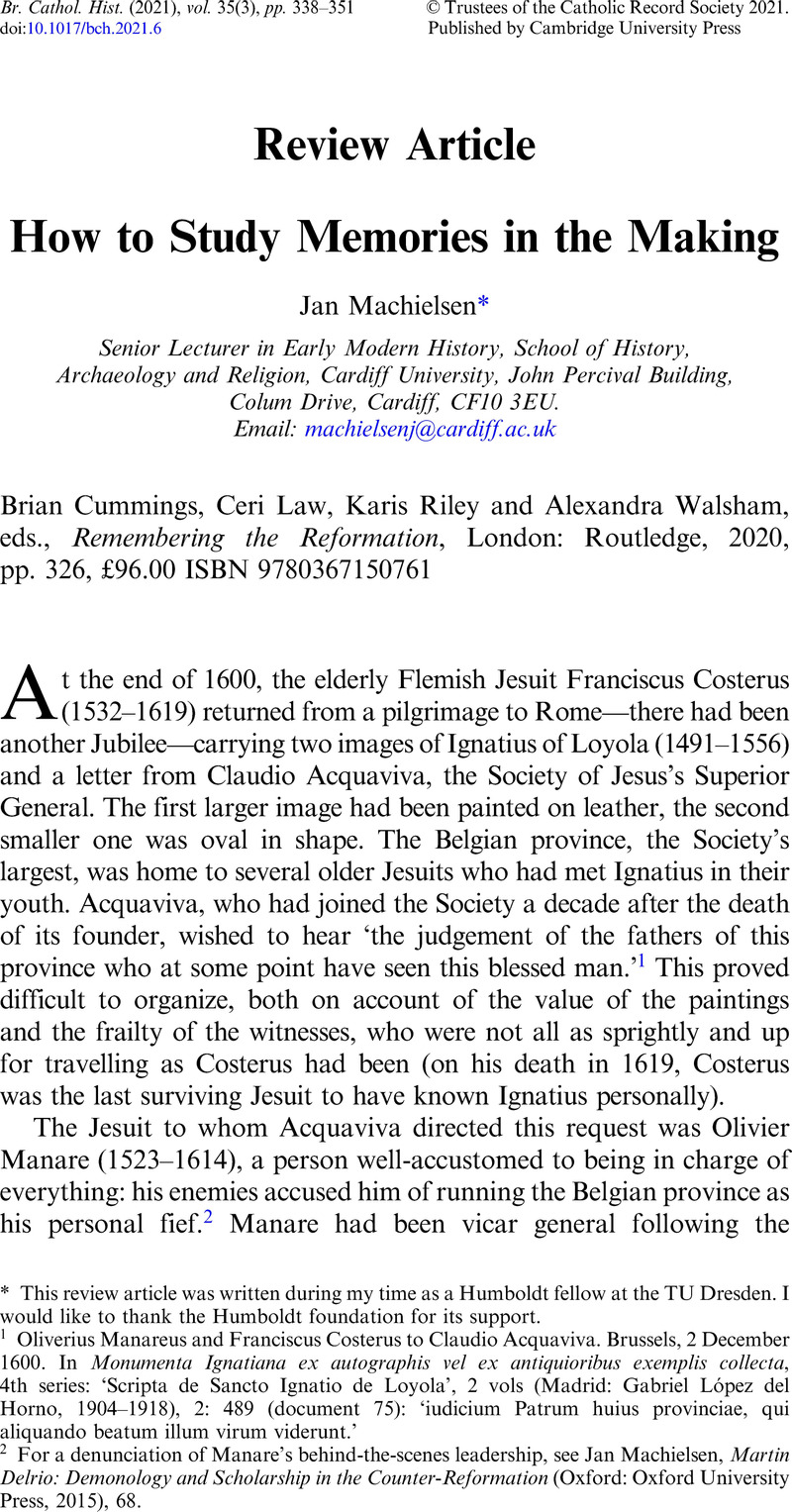No CrossRef data available.
Article contents
How to Study Memories in the Making
Review products
Published online by Cambridge University Press: 17 May 2021
Abstract

- Type
- Review Article
- Information
- Copyright
- © Trustees of the Catholic Record Society 2021. Published by Cambridge University Press
Footnotes
This review article was written during my time as a Humboldt fellow at the TU Dresden. I would like to thank the Humboldt foundation for its support.
References
1 Oliverius Manareus and Franciscus Costerus to Claudio Acquaviva. Brussels, 2 December 1600. In Monumenta Ignatiana ex autographis vel ex antiquioribus exemplis collecta, 4th series: ‘Scripta de Sancto Ignatio de Loyola’, 2 vols (Madrid: Gabriel López del Horno, 1904–1918), 2: 489 (document 75): ‘iudicium Patrum huius provinciae, qui aliquando beatum illum virum viderunt.’
2 For a denunciation of Manare’s behind-the-scenes leadership, see Jan Machielsen, Martin Delrio: Demonology and Scholarship in the Counter-Reformation (Oxford: Oxford University Press, 2015), 68.
3 Rome, Archivum Romanum Societatis Iesu [ARSI], Vitae 84, fol. 5v: ‘sed Deo alium designante’. On his worthiness to become Superior General, see also ibid., fol. 56r–v.
4 Monumenta Ignatiana, 4th series, vol. 2, 489.
5 ‘Diversorum patrum iudicia de imaginibus P. Ignatii.’ Brussels, 9 December 1600. Monumenta Ignatiana, 4th series, vol. 2, 494 (document 77): ‘illa nimis parum accedat ad veram B. Patris effigiem.’
6 Ibid.: ‘a labro inferiore ad mentum inclusive’.
7 Ibid., 495; Olivier Manare to Claudio Acquaviva. Brussels, 9 December 1600. Monumenta Ignatiana, 4th series, vol. 2, 493 (document 76).
8 Olivier Manare to Claudio Acquaviva. Brussels, 15 December 1600. Monumenta Ignatiana, 4th series, vol. 2, 495 (document 77): ‘quia bonus hic Pater, audito Patrum caeterorum judicio, et secum omnia expendens, visus sibi est posse alteram imaginem obtinere a pictore secundum cor suum, et quae futura sit B. Patri persimilis. ’
9 Franciscus Costerus to Claudio Acquaviva. Brussels, 31 December 1600. Monumenta Ignatiana, 4th series, vol. 2, 495 (document 81): ‘Nullam hactenus vidi quae verius B. P. repraesentet.’
10 Zsuzsanna van Ruyven-Zeman, Hollstein’s Dutch and Flemish Etchings, Engravings and Woodcuts, 1450–1700, ed. Jan van der Stock and Marjolein Leesberg (Rotterdam: Sound and Vision Publishers, 2004), vol. LXV: The Wierix Family, Part VII, 102–107, lists several engravings of Ignatius by the Flemish artist Hieronymus Wierix, although not the version included here. The earliest of these (image no. 1520) dates to 1596. Figure 1 seems to be later but earlier than (undated) images 1517/1 and 1519. All of these versions predate Ignatius’s beatification in 1609. Although never before connected with the correspondence cited, Figure 1 seems to match the written descriptions (note the age lines, the larger forehead, the shortened chin) quite well.
11 The ‘stanze’ where Ignatius spent the last twelve years of his life are part of the professed house next to the Gesù, where they can still be visited. They are all that remain of the original building. Acquaviva ordered them preserved when the rest of the building was rebuilt around the time these letters were written: [https://www.chiesadelgesu.org/le-stanze-di-santignazio/ Accessed 04/01/2021].
12 Monumenta Ignatiana, 4th series, vol. 2, 490–91 (document 75): ‘ Non erat beato Patri color niger aut valde fuscus, sed neque candidus; erat medius inter nigrum et candidum … et aspergebatur ipse color supernaturali quodam splendore, quui miram gratiam addebat, ut oblectaret intuentem, sicuti bene notavit beatus ille vir Philippus Nerius, princeps Oratorii, sicuti retuli ipse, tempore ultimae congregationis, mihi et Patri Mutio Viteleschi.’
13 John W. Padberg et al., For Matters of Greater Moment: The First Thirty Jesuit General Congregations (St Louis, MO: Institute of Jesuit Sources, 1994), 10–13.
14 Monumenta Ignatiana, 4th series, vol. 2, 491.
15 Olivier Manare, Exhortationes super instituo et regulis Soc. Iesu (Brussels: De Meester, 1912).
16 Decreta congregationum generalium Societatis Iesu (Antwerp, 1635), 331.
17 On this campaign and the papal backlash that followed see Ruth S. Noyes, Peter Paul Rubens and the Counter-Reformation Crisis of the Beati moderni (London: Routledge, 2017), especially chap. 2.
18 ‘Excerpta ex processibus remissorialibus’ in Monumenta Ignatiana, 4th series, vol. 2, 811 (doc. 97): ‘Fama de illo crebra erat et constans quod esset vir sanctus.’ This testimony belongs to 78-year old Eleutherius Pontanus, but all four offer variants on the same theme.
19 For their biographical details, see their entries in Willem Audenaert, Prosopographia Iesuitica Belgica Antiqua: A Biographical Dictionary of the Jesuits in the Low Countries (Leuven-Heverlee: Filosofisch en Theologische College S.J., 2000), volumes 1 and 2.
20 Geoffrey Cubitt, History and Memory (Manchester: Manchester University Press, 2007), kindle ed., loc. 213.
21 Pierre Nora, ‘Between Memory and History: Les Lieux de Mémoire’, Representations 26 (1989): 7–24, at 8.
22 Peter Marshall, 1517: Martin Luther and the Invention of the Reformation (Oxford: Oxford University Press, 2017).
23 Nora, ‘Between Memory and History’, 8.
24 Eamon Duffy, The Stripping of the Altars: Traditional Religion in England, 1400–1580, 2nd ed. (New Haven: Yale University Press, 2005); idem, The Voices of Morebath: Reformation and Rebellion in an English Village (New Haven: Yale University Press, 2001).
25 Ribadeneyra joined the Society just before his fourteenth birthday in 1540, a few days before it received official papal approval: Jodi Bilinkoff, ‘The Many “Lives” of Pedro de Ribadeneyra’, Renaissance Quarterly 52/1 (1999): 180–96. For Manare’s criticism, see Monumenta Ignatiana, 4th series, vol. 2, 490 (doc. 75).
26 Mauric Halbwachs, ‘From The Collective Memory’, in Jeffrey K. Olick et al., eds. The Collective Memory Reader (Oxford: Oxford University Press, 2011), 139–49, at 141.





